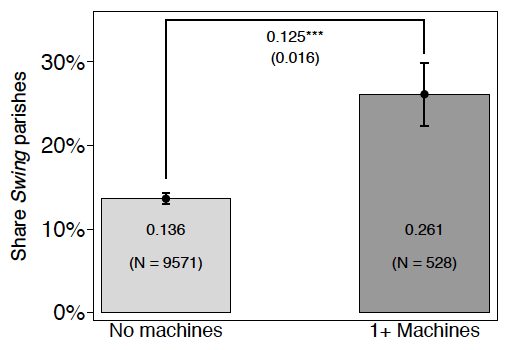
If technology-induced job losses are rapid, and affect a large part of the workforce, the risk of unrest can quickly become serious
The history of economic growth over the last 250 years is also the history of job destruction. Since the start of the Industrial Revolution, new machinery has wiped out countless jobs and replaced millions of workers. Mechanisation has also transformed the economy – since the 1800s, it turned agriculture from a main source of employment into a marginal sector (Crafts 1985). More recently, job losses have spread to manufacturing and service jobs – computers today perform many routine tasks that used to give work to thousands of people, from telephone operators to secretaries (Autor et al. 2003).
The seeds of destruction
The idea that capitalism holds the seeds of its own destruction is as old as the Industrial Revolution. David Ricardo believed that new machines hurt workers because they bid down wages and undermined their standards of living. Karl Marx even predicted that new technologies would impoverish the working class to the point that the proletariat would eventually rise against the established social order and start the Revolution.
New technologies, unanswered questions
Job losses driven by new technologies bring lasting harm to displaced workers – even when these workers find new occupations, they rarely recover from the initial shock (Autor et al. 2014). At the same time, not all new technologies bring disruption, and only some are met by workers’ resistance. When do new technologies diffuse smoothly, and when does their adoption spell trouble? When do workers resist the introduction of new technologies, either demanding protection from them or organising a violent reaction?
To answer these questions, we look at the biggest wave of unrest to erupt in English history – the ‘Captain Swing’ riots of 1830-32.1 In hundreds of attacks, thousands of rural workers torched farm buildings, destroyed machines, attacked local officials, and threatened even greater violence. In the end, it was only after more than one year and through the use of troops that the government reasserted control over the countryside.
The Swing riots
Many stories have been told about the origins of the Swing riots. Historians debate whether labour market competition from Irish immigrants, discontent over the Poor Laws, or 'contagion' from the 1830 rebellions in Brussels and Paris were the key factors leading to unrest (Aidt et al. 2017). In “Rage against the machines” (Caprettini and Voth 2018), we argue that one of the major determinants of the riots was the adoption of a new labour-saving technology: the threshing machine.
Threshing grains after the harvest was a key part of agricultural production in the early 1800s. During winter, rural workers earned more than 40% of income with threshing. They performed it manually, by beating the corn with sticks in a bid to separate the grain from the chaff (Clark 2001). The invention of a Scottish engineer, Andrew Meikle, made it possible to save hundreds of hours of labour. Horse or water-powered threshers could perform a job that previously took an entire winter in a matter of days. These machines started spreading at the beginning of the 1800 and we argue that they played a key role in leading to the 1830 riots.
Our study: The relationship between threshing machines and riots
To clarify this link, weassemble a new, finely-grained dataset on the adoption of threshing machines. Farms for sale or lease were advertised in newspapers, and the description of the property would typically mention the type of equipment available. We collect these data from over 60 newspapers across England. This tells us where threshing machines were in use before the riots.
Areas with more threshing machine adoption before 1830 saw greater unrest during the Swing riots. Having at least one threshing machine doubled the risk of experiencing an arson attack, a threatening letter, or an act of destruction (Figure 1). This is even likely to understate the effect that new technology had on the risk of unrest – whenever farmers feared violent resistance to the introduction of new machinery, they may have been more cautious in adopting threshing machines.
Figure 1 Threshing machine adoption and unrest

To circumvent this problem, we look at two factors that made the adoption of the new technology more likely:
- the suitability of a region for wheat cultivation; and
- he availability of sufficient water-power
Early threshing machines – for technological reasons – were only useful for threshing wheat (Hobsbawn and Rudé, 2014). Using soil suitability data from the FAO-GAEZ (Food and Agriculture Organisation-Global Agro-Ecological Zones) database we establish which areas are more suited to wheat production. These areas (in green on the left map in Figure 2) saw greater unrest in 1830, as indicated by more frequent and larger black circles.
Figure 2 Left: wheat suitability and the location of Swing riots (black circles); Right: water-power availability and Swing riots (white circles)

Not all wheat-producing areas were equally likely to adopt the new machines. Where water power was available in abundance, the new technology was more attractive. Based on geological data on the volume and direction of water flowing in a parish, we create an index of suitability for water-power use: the accumulation flow. In combination, wheat suitability and accumulation flow are strong predictors of the adoption of threshing machines. We also show that the higher the suitability for wheat, and the more water is available for driving machinery, the greater the level of unrest. The three panels on the right of Figure 2 visualise the relationship between water power availability and riots in three separate regions of England. They reveal that within relatively homogeneous agricultural areas, riots were more common where more water flows. This makes it more likely that machine adoption actually caused political unrest.
Unrest in 1830 also had negative long-term effects. Where unrest broke out, farmers subsequently avoided installing new machines – and not just threshing machines. In addition, inventive activity went down. Looking at patent data, we find that the further a parish was from violent riots and unrest in 1830, the higher the patenting rate – a pattern that was not visible in the data prior to 1830.
What could have been done to avoid the unrest?
Outside options mattered. Where workers could easily work elsewhere because their agricultural parish was relatively close to a large, thriving urban labour market, the new machines did not spell trouble. In contrast, the more remote a parish was, and the less vibrant the next market town, the higher the risk of instability. We also find some suggestive evidence that England's embryonic welfare state helped to keep the social peace. Under the Poor Law, support varied at the local level. The more generous a parish was, the lower the correlation between threshing machines and unrest.
Concluding remarks
Our results tell a cautionary tale. If technology-induced job losses are rapid, and affect a large part of the workforce, the risk of unrest can quickly become serious. New technologies may increase output overall, but gains do not necessarily compensate for the losses – and the losers do not always suffer in silence. For societies to adopt better technology, enhancing productivity and wealth overall, they need ways to cushion the blow. This can be done either by offering alternative employment in thriving sectors or by providing minimum income guarantees.
References
Aidt, T, G Leon and M Satchell (2017), “The social dynamics of riots: Evidence from the Captain Swing Riots, 1830–31”, Manuscript.
Autor, D, F Levy and R Murnane (2003), “The skill content of recent technological change: An empirical exploration”, The Quarterly Journal of Economics 118(4): 1279–1333.
Autor, D, D Dorn, G Hanson and J Song (2014), “Trade adjustment: Worker-level evidence”, The Quarterly Journal of Economics 129(4): 1799-1860.
Caprettini, B and HJ Voth (2018), “Rage against the machines. Labour-saving technology and unrest in England 1830-32”, CEPR Discussion Paper 11800.
Crafts, N (1985), “British economic growth during the Industrial Revolution.” Oxford: Oxford University Press.
Clark, Gregory (2001), “Farm wages and living standards in the Industrial Revolution: England,1670–1869.” The Economic History Review54 (3): 477–505.
FAO-GAEZ. Fischer, G, FO Nachtergaele, S Prieler, E Teixeira, G Tóth, H van Velthuizen, L Verelst and D Wiberg. 2011. “Global Agro-Ecological Zones (GAEZ v3.0).” Rome, Italy: Food and Agriculture Organization (FAO). http://www.fao.org/nr/gaez/en/.
Hobsbawm, E and G Rudé (2014), [1969], Captain Swing, Verso.
Endnotes
[1] Captain Swing was the name of a mythical character who fought on the side of the workers; in the years of the riots, English landlords received hundreds of threatening letters signed by Swing.

